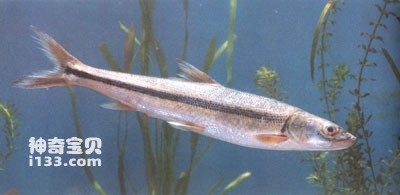Luciocyprinus langsoni (Luciocyprinus langsoni) belongs to the order Cypriniformes, family Cyprinidae, subfamily Luciocyprinus, and genus Luciocyprinus. Commonly known as: pole fish, stick fish, fragrant flower fish, ink line fish, and pole fish. English name: Shutfle-like carp.
Endangerment level: Vulnerable.
The body is long, round and rod-shaped, slightly flattened laterally behind the dorsal fin, and the ventral edge has no edges. The head is longer and its length is greater than the height of the body. The snout is pointed and conical. At the end of the mouth, the cleft is very deep and almost horizontal, the upper and lower jaws are almost equal in length, and the end of the upper jaw reaches or exceeds the vertical line of the edge of the eye; the lips are thicker and tightly wrapped around the surface of the jaw, and there is a protrusion on the inside of the symphysis of the mandible, which is similar to The upper jaw is inlaid with a depression; the posterior labial groove extends forward and is interrupted by the chin. No need. The eyes are large, set high and protruding. The head behind the eyes is much longer than the snout. The gill openings are large. The scales are small, with 90-100 lateral line scales. The starting points of the dorsal and pelvic fins are opposite, and the dorsal fin has no spines; the tip of the caudal fin is deeply forked; other fins are short. The dorsal side of the body is blue-gray with dark red, and the abdomen is silvery white. There are 3-4 rows of longitudinal scales with black stripes along the central axis of the body side. The posterior segment is dark in color, and the dorsal side of the caudal peduncle is bright red.

Lives in the middle and upper layers of open water in large rivers and lakes, and is good at swimming. It also likes to live in places with rocky substrate. Young fish eat zooplankton and fry, while adults feed exclusively on fish. Sexual maturity occurs later. The reproductive season is generally from March to May. Spawning requires flowing water conditions, so they usually breed on rapids and beaches. There is no obvious aggregation phenomenon of juvenile fish, and they live in the slow flow or still water of tributaries. Every year, the rising water flows up the river, and the receding water flows down the river.
It is mainly distributed in the Xijiang and Nanpanjiang river systems, as well as Yilong Lake in southeastern Yunnan and southern Guizhou; abroad it reaches parts of Vietnam, such as Lang Son and other places.
In the past, it was an economic fish in the production area. Because it is a ferocious carnivorous fish with a large body, rich and tender meat, and delicious meat, it is a high-quality fish and is the main target of fishing in the production area. Excessive fishing in recent years, including illegal fishing methods such as electrocution, poisoning, and bombing, as well as the construction of water conservancy projects and dams in the upper reaches of rivers, have hindered the migration channels of this fish and damaged the ecological environment; in addition, the reclamation of lakes and farmland have Pumping water for irrigation has led to a sharp drop in water levels and the destruction of fish habitats and breeding sites. As a result, the amount of resources has dropped sharply, and it has now become a vulnerable species.
animal tags:
We created this article in conjunction with AI technology, then made sure it was fact-checked and edited by a Animals Top editor.